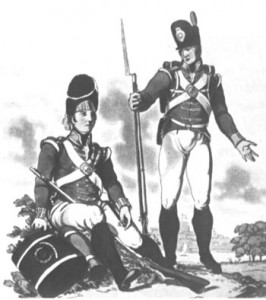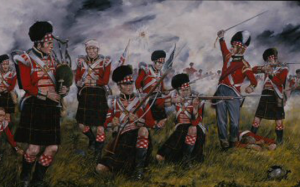An officer in the Napoleonic Wars
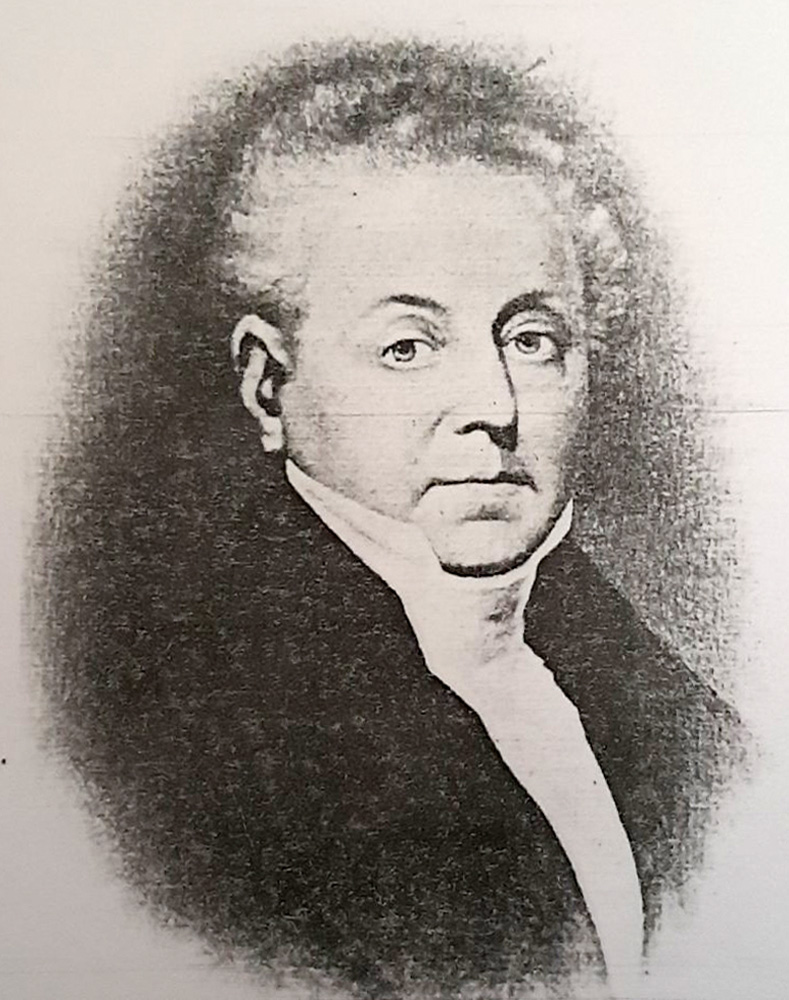
Isaac Chetham is my 5th Great Grandfather and was involved in the Peninsula War fighting with the infantry regiments 29th Foot, 79th Foot and 40th Foot.
Like Richard Sharpe in the novels, he joined the army in 1799 aged 16 and rose through the ranks in the 29th Foot from Private to Corporal, Sergeant and Sergeant Major. On 6th August 1811 Isaac, on Wellington’s personal recommendation, was commissioned as an Ensign in the 79th Foot. He was later promoted to a Lieutenant and swiftly to Adjutant in 40th Foot.
I discovered that he was a veteran soldier when researching through the 1851 Census Records where he was described as a “Lieutenant Half Pay 40th Regt” which in effect meant he was on a pension worth half of his normal wages and so an ex-soldier. In the 19th century British Army half-pay referred to the pay or allowance an officer received when in retirement or not in actual service.
Prior to that I have Census clues that he was in Halifax, West Yorkshire in 1841 and Halifax, Nova Scotia – both associated with the British Army. From this information I was able to search the internet for more information particularly Challis’s Penisular Roll Call.
UPDATE: Erica Peacock researched and wrote an article in 2015 about Isaac Chetham on the National Archive website called Isaac Chetham: From ‘Scum of the Earth’ to Commissioned Officer in Wellington’s Army
UPDATE: March 2017 I have been contacted by a distant cousin, Sandie Jackson, who’s father has done some extensive research on Isaac Chetham in the past. I now have a lot more information about him which I will post in due course.
Source: War Office Circular Return 1828
The War Office sent out a circular in October 1828 to retired officers on full, or half, pay. Isaac Chetham’s return is held at The National Archives (WO 25/753/49).
Transcript of the 1828 Return
Christian and Surname of the Officer: Isaac Chetham
Age on first Appointment to His Majesty’s Service: 16 years
Dates of first Appointment, and of each subsequent Promotion, Removal, or Exchange, whether to Full-Pay or Half-Pay: 1797 – 8 – Enlisted the 29th Regt continuous???? 3 years-6months – a Private Soldier – Two years a Corporal – 8 years-6 months – Sergeant, and three months Sergt Major. Promoted to an Ensign 79th Regt. 6th August 1811 – Promoted to Lieutenant 79th Regt. 10th December 1812 and immediately removed to the 40th Regiment Adjutant.
Regiments in which the several Commissions have been obtained, or upon the Half-Pay of which the Officer may have retired: Both Ensign and Lieutenant were obtained in His Majesty’s 79th Regt. and removed to 40th Regt. and placed on H.P. 40th Regt in consequence of a reduction of the establishment.
[Source: National Archives]
Source: Lionel S. Challis’s Peninsula Roll Call
Captain Lionel S. Challis of the Queen’s Westminster Rifles, began a project which would last 30 years. He developed a list of every British Army officer who served in the Peninsular War from 1808-1814. Captain Challis scoured Army Lists, Gazettes, despatches, official records, and regimental histories for information. He recorded on to index cards his findings on over 9,600 officers. In 1949 he donated his research to the Royal United Services Institute (RUSI) who still hold the original cards in their library. Peninsular Roll Call
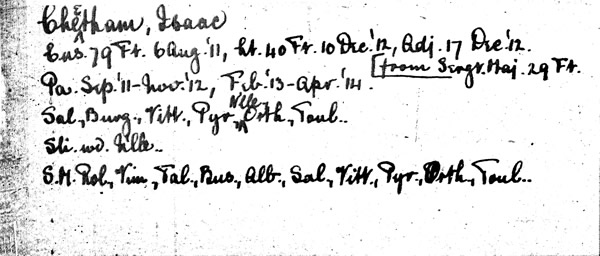
Transcript of the Isaac Chetham’s Penisula Record
The Peninsula Roll Call has many abbreviations and shorthand, so here’s the record in plain English!
Cheetham, Isaac. Ensign 79th Foot 6th August 1811, Lieutenant 40th Foot 10th December 1812, Adjutant 17th December 1812. From Sergeant Major 29th Foot.
Served in the Peninsula between the following dates: September 1811 – November 1812 and February 1813 to April 1814
Salamanca, Burgos, Vittoria, Pyrenees, Nivelle, Orthes, Toulouse.
Slightly Wounded Nivelle.
Army General Service Medal (Clasps): Rolica, Vimiero, Talavera, Bussaco, Albuhera, Salamanca, Vittoria, Pyrenees, Orthes, Toulouse
[Source: Lionel S. Challis’s Peninsula Roll Call]
TIMELINE: Isaac Chetham military service and battle chronology
- 1781 Born
- 1797 Joined the Army aged 16 in the 29th Foot as a Private c. 6 May
- 1799 ⚔️First action as part of the Duke of York’s expedition to the Netherlands.
- 1800 Promoted to Corporal c. 6 November
- 1802 Promoted to Sergeant c. 6 November whilst stationed in Halifax, Nova Scotia.
- 1802 Married Mary Morel on 7 December
- 1803 Mary Ann born on 15 September
- 1805 Edward born on 27th May
- 1807 September: 29th Foot return to England and leave for the Peninsular in December.
- 1808 ⚔️Rolica 17 August
- 1808 ⚔️Vimiero 21 August
- 1809 ⚔️Talavera 27–28 July
- 1810 ⚔️Bussaco 27 September
- 1811 Sergeant Major 29th Foot c. 6th May
- 1811 ⚔️Albuhera 16 May
- 1811 Ensign 79th Foot 6 August on Wellington’s personal recommendation
- 1812 ⚔️Salamanca 22 July – a key turning point in the Peninsula War
- 1812 Lieutenant 40th Foot 10 December
- 1812 Adjutant 40th Foot 17 December
- 1813 ⚔️Vittoria 21 June
- 1813 ⚔️Pyrenees 25 July
- 1813 ⚔️Injured at The Battle of Nivelle 10 November
- 1814 ⚔️Orthez 27 February
- 1814 ⚔️Toulouse 10 April
- 1816 Elizabeth born on 11 August
- 1828 Responds to a circular return sent out by the War Office
- 1841 Army Half Pay at No 1 Street, Northowram, Halifax, West Yorkshire
- 1851 Army Half Pay at Mansfield Road, Nottingham
- 1854 Died of natural causes
[Source: Summary of all sources]
Regiments
The War Office sent out a circular in October 1828 to retired officers on full, or half, pay. Isaac Chetham’s return is held at The National Archives (WO 25/753/49) and fully details his Army career.
29th (Worcestershire) Regiment of Foot 1797 to August 1811
RANK: Private, Corporal, Sergeant and Sergeant Major
SERVICE PERIOD: 1797 – August 1811
Isaac Chetham was recorded as “from a Sergeant Major in 29th Foot” on his record and as an NCO would not have such detailed records as those when he became an officer.
Regimental Sergeant Major
The RSM will be an example to all in dress, demeanor and conduct both in and out of barracks. He will at all times be active and zealous for the reputation of the Battalion and will endeavour in every way to set a tone corresponding to the great responsibility and trust of his position. He will continuously observe the character and conduct of the NCOs, encourage their professional development, and be unremitting in detecting and checking any neglect of duty or unsportsmanlike conduct on the part of either NCOs or Kingsmen. He must not hesitate to bring to the notice of the Commanding Office or Adjutant, as appropriate, any matter which he may consider would be beneficial or prejudicial to the interests of the Battalion, and must always be prepared to give confidential advice to the Commanding Officer. The Sergeants’ Mess is under his immediate direction, as is the Corporals’ Mess, and he is responsible for their good order, tone and regularity.
He will keep the senior NCOs’ duty rosters with accuracy and fairness, and in detailing the number of soldiers each company is to provide daily for duty he will be careful that each furnishes its proper proportion. At the proper time, he will parade at the Orderly Room all accused and witnesses, and others who are brought before the Commanding Officer. He will ensure that they are sober, clean and properly dressed. He will set the standard of drill in the Battalion and will frequently attend Guard Mounting and such other parades as may be ordered.
Company Regimental Sergeant Major
The CSM is to the Company as the RSM is to the Battalion, and he must at all times both set an example of soldierly conduct and character and maintain the highest standards within the Company. He is responsible to his Company Commander for the good order of the Company both in barracks and the field. The CSM will carefully and in detail superintend the Company routine, ensure that all returns are submitted at the proper time, and that the Officer Commanding the Company is kept informed of all matters concerning the Company which should be brought to his knowledge and attention. He will take great pains in the instruction of the Junior NCOs in their duties and will render advice, encouragement and assistance to all NCOs and Kingsmen.
History
Isaac Chetham saw his first action in 1799 during the Napoleonic Wars in the Anglo-Russian invasion of Holland, a campaign of 27 August to 19 November 1799 during the War of the Second Coalition, in which an expeditionary force of British and Russian troops invaded the North Holland peninsula in the Batavian Republic.
The campaign had two strategic objectives: to neutralise the Batavian fleet and to promote an uprising by followers of the former stadtholder William V against the Batavian government. The invasion was opposed by a combined Franco-Batavian army of equal strength.
The Anglo-Russian forces were successful at first, defeating the defenders in the battles of Callantsoog and the Krabbendam. Subsequent battles went against the Anglo-Russian forces and following the defeat at Castricum, the Duke of York, the British supreme commander, decided upon a strategic retreat to the original bridgehead in the extreme north of the peninsula. An agreement was negotiated with the supreme commander of the Franco-Batavian forces, General Guillaume Marie Anne Brune, that allowed the Anglo-Russian forces to evacuate this bridgehead unmolested.
In 1808, the 29th were sent from England to Cadiz, in Southern Spain, but were ordered to proceed to Mondego Bay, in Portugal, to join Wellesley’s Army. The latter, wishing to force the French out of Portugal into Spain, attacked the enemy at Rolica. The French position was strong and could only be assailed through defiles.
The 29th Foot forced their way through the defiles before the other troops were able to come into line. They found themselves facing overwhelming odds, but without waiting for reinforcements attacked with great vigour and drove the enemy from its position.
Four days later the 29th took part in the indecisive battle of Vimiero after which the Convention of Cintra was signed and the French evacuate Portugal.
The 29th next distinguished themselves during the battle of Talavera in 1809. General Hill, whose horse had been shot under him, led the 29th in a charge, completely routing the enemy. After the battle, Sir Arthur Wellesley reported on the 29th, “It is the best Regiment in this Army”.
In 1811, the 29th took part in the Battle of Albuhera. The following extract is from “Battles and Sieges of the Peninsular” – “Great was the disorder on the hill. In one part the shrinking Spaniards were blindly firing, though the British Troops were before them, and in another part flying before the Lancers, would have broken through the 29th, then advancing to the succour of the 43rd; but, terribly resolute, the 29th smote both friends and foes without distinction in their onward progress.”
It was during this battle that Ensign Richard Vance, who had only seven months service, was carrying the Regimental Colour. Seeing the desperate plight of the Regiment, he tore the Colour from its pole and hid it under his coat, rather than let it fall into the hands of the enemy. He was found dead after the battle lying where the fighting was hottest, with the Colour of his Regiment still in the breast of his coat the pole lying by his side.
The 29th Foot returned home after the Battle of Albuhera 16 May 1811 to recruit more soldiers due to heavy casualties. Isaac Chetham was removed to the 79th Foot after this.
79th Foot Queen’s Own Cameron Highlanders 6th August 1811 to December 1812
RANK: Ensign
SERVICE PERIOD: 6th August 1811 – December 1812
On 6th August 1811 Isaac, on Wellington’s personal recommendation, was commissioned as an Ensign in the 79th Foot (letter from Wellington: WO 31/328).
Transcription of letter from Wellington
Quinta de St João July 18th 1811
Sir
Having on the 11th of June last recommended the appointment of Sergeant Bayley of the 29th Regt. to an Ensign in the the 79th who is since dead, I beg now to submit the name of Sergeant Major Chetham of the 29th Regt. may be substituted for that of Sgt. Bayley.
I have the Honor to???
Sir
Your most obedient servant
Wellington
Mdonel Sorrens??
[Source: National Archives letter from Wellington: WO 31/328]
Ensign
An Ensign looked after the Battalion flags known as colours: the First, or “King’s Colour”, and the Second, or “Regimental Colour”. The First had the Union Flag with the Regiment’s number LXXIX, surrounded by a wreath. The Second was in the colour of the regimental facings with a small Union Flag in the corner and the regimental number LXXIX in centre. The colours were carried into battle for identification, and as a rallying point, in the care of Ensigns or Sergeants. Attending the colours in battle was dangerous, since they were a target for enemy artillery and assault. Due to the symbolic significance of the colours, their loss was a grave issue, and extreme measures were often taken to prevent such dishonour occurring.
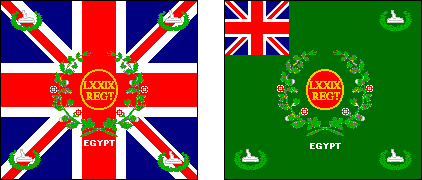
Brief history 1811-1812
In 1808 the 79th Foot moved to Portugal and then Spain where it took part in various engagements of the Peninsular War.
Isaac Chetham was involved in the Battle of Salamanca 22 July 1812 with the 79th Foot.
40th (2nd Somersetshire) Regiment of Foot
RANK: Lieutenant and Adjutant
SERVICE PERIOD: August 1811 – December 1812 and beyond
From the 1851 Census I know that Isaac Chetham was on a Half Pay pension from 40th Foot in 1851 and also on his gravestone, so can probably assume he never changed regiments again after the Peninsular War. I have seen references to his Half Pay starting in 1817.
Lieutenant
In the Napoleonic Wars, companies were commanded by captains, with lieutenants and ensigns (or subalterns) beneath him.
Adjutant
The Adjutant of a Battalion will normally be of captain’s rank and his tour of duty will usually be for two years. The appointment of an officer as Adjutant is a mark of distinguished conduct and ability. The appointment of Adjutant is one to which all junior officers should aspire and will invariably be filled by an officer of the Regiment. The Adjutant is responsible within the Battalion for executing the Commanding Officer’s policy and orders. Irrespective of his seniority, the Adjutant’s orders on matters of routine and discipline, in so far as they represent the policy of the Commanding Officer, are to be carried out without question. The Adjutant is directly responsible for the standard of dress, turnout and discipline of all Battalion officers below field rank.
Brief history
The 40th Foot was formed in 1717 in Nova Scotia and was then known as Phillips’ Regiment of Foot, from the name of its first Colonel, then Governor of Nova Scotia. From 1717 to 1743, Phillips Regiment was mainly garrisoned at Annapolis, Placentia and Canso. When war was declared against France in 1744, Phillips Reg’t held the attack at Annapolis but fell at Canso, but the following year Nova Scotia was saved. 1751 saw it become “40th Regiment of Foot”. In 1755, the 40th helped drive the French out of Nova Scotia.
In 1758 with Britain in its final struggle with France over the sovereigncy of Canada after which it became a British Colony.
In 1761 the 40th moved from Canada to the West Indies to take the French outpost of Martinique, followed by Cuba and in June beseiged Havana after Spain declared war on England. This war ended in early 1763 and the 40th Reg’t arrived in the British Isles in 1765, 48 years after its formation.
With America embroiled in its War of Independance with Britain, the 40th arrived in Boston in 1775 ready for active service. The Regiment earned high praise for its conduct in the war. In 1778 the 40th left America for the West Indies but returned to New York in September, 1781.
In 1782 the 40th became “The 40th Regiment 2nd Somersetshire”. The 40th returned to England in 1783 after the peace treaty of Versailles. Between the years 1793 and 1799, the Reg’t was active against the French in Holland and St Vincent, and garrison duty at Gibraltar, Minorca and Malta.
In 1800 the 40th was part of the force at the landing at Abourkir Bay near Alexandria, Egypt, and the Flank companies distinguished themselves so well that they were granted the distinction of wearing the “Sphinx-superscibed Egypt”.
In 1807 the Reg’t took part in a short campaign in South America where the 40th earned the battle honour “Montevideo” and from Sth America the 40th sailed to Portugal for the start of the Peninsula War. Here the British under Wellington fought Napoleons army for six weary years and eventually drove them from Portugal through Spain and back into France. The 40th Reg’t earned thirteen hard fought battle honours from “Rolica to Toulouse”.
The 40th returned to England in 1814, but were soon back in Europe again where at Waterloo the fate of Napoleon was finally decided. For their steadfastness and discipline on this day the 40th were awarded the battle honour “Waterloo” and permitted to encircle their badge with a laurel wreath.
[Source: Notes on 40th Foot in the Peninsula War]
Wounded
10th November 1813 (on the Nivelle)
PUA 657
Cole’s Division is under the overall command of Beresford and in a central position in the line of attack, Anson’s Brigade have before them the Santé Barbara fortification it is resting on top of a rocky hill and is well armed. The day begins early as 1/40th advance over the uneven terrain, their battery delivering a barrage of shrapnel to soften up the garrison who, as soon as their attackers close up presenting bayonets, take to their heels. Carrying on the advance the Brigade joins others on their right, cross the river and, as the village of Sare is reached take it at the run, General Conroux the enemy Divisional commander is killed in this fight, which is contested for a short while. Reforming for yet another push forward the next goal is a strongpoint Louis XIV which the enemy had not expected to have to defend so soon, it was inadequately manned and as a result also fell to 4th Division.
Elsewhere the assaults had all gone well so that if all is not to crumble about their ears the enemy must put up a real fight somewhere, Clausel, who so often has had to make a stand where others have already failed brings down a sharp artillery response in the shape of close range canister fire and it is to be expected that this is where 1/40th will collect most of its casualties this day. Recovering and coming on again Anson’s men eject General Maransin’s men from the Louis XIV works capturing that General for a spell, he escapes in the confused fighting here which after swinging back and forth, finally sees 1/40th and their comrades in possession.
Having accomplished all that was required of them 4th Division stands down and counts heads, Brevet Lieutenant Colonel Henry Thornton, Captain Peter Bishop, Lieutenants Carter, John Richardson and Lieutenant/Adjutant Isaac Chetham are all wounded as are 80 of their men, one un-named officer is dead with 15 men, so, 1/40th will show;
10th November (after the combats at the Nivelle)
PAB 555
By the end of the day the Division finds quarters by the little town of Serres and, as it turns out will have no more contact with the enemy for the rest of the year. Late autumn rains herald a cold miserable winter with the CIC still manœuvring the army up to the River Nive and probing forward up to the armed camps about Bayonne, a number of fierce fights are brought on by this but, 4th Division are kept to the rear with little chance of coming up to these actions, mainly due to the washing out of bridges and of course the rivers of mud which the roads and pathways have become whilst attempting to keep the army active in the winter rains. During January when the army is eventually forced into quarters by the weather we see sure figures presented, 1/40th at this time with a possible 165 men sick or injured and out of contention.
[Source: Notes on 40th Foot in the Peninsula War]
Medals
As a member of the British Army, Isaac Chetham was awarded The Military General Service Medal (MGSM) for military actions from 1793 to 1814; a period covering the French Revolutionary Wars, the Napoleonic Wars, and the Anglo-American War of 1812. Each battle or action covered by the medal was represented by a clasp on the ribbon, with twenty-nine bars been awarded.
The medal was only awarded to surviving claimants. The Claimant had to survive until 1847 and then actively apply for it.
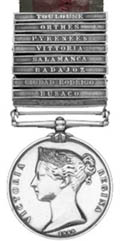
Clasps awarded
Death
Isaac Chetham died aged 73, from natural causes at his home in Nottingham on 19th October 1854 (death certificate: WO 42/8/C306).
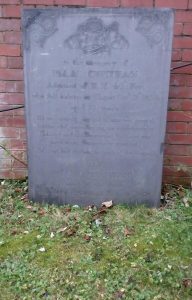
CHETHAM, Isaac
Lieutenant. 40th (2nd Somersetshire) Regiment of Foot.
Headstone: General Cemetery, Nottingham, Nottinghamshire.
[box border=”full”]Sacred / to the memory of / ISAAC CHETHAM, /
Adjutant of H.M. 40TH FOOT, / who fell asleep in Christ, OCT. 19th 1854, / aged 73 years. /
He was actively engaged actively engaged in nineteen general / battles and sieges during the expedition to / Holland and the Peninsular War, and was / three times dangerously wounded. /
He lived and died in the faith of the Gospel. / Also, / MARY CHETHAM / widow of the above / who died at Sheffield Nov. 26th 1859 / aged 87[/box]
Pte 29th Foot 1797. Cpl 1800. Sgt 1802. Sgt Major 1811. Ensign 79th Foot 6 Aug 1811. Lt 40th Foot 10 Dec 1812. Adjutant 17 Dec 1812.
Served in the Peninsula with 29th Foot Aug 1808 – Jul 1811, with 79th Foot Sep 1811- Nov 1812 and with 40th Foot Feb 1813 – Apr 1814.
Present at Rolica, Vimeiro, Douro, Talavera, Busaco, Albuera, Salamanca, Vitloria, Pyrenees, Nivelle (wounded), Orthes and Toulouse.
Also served at The Helder 1799. Retired on half pay 25 Mar 1817. MGS medal for Rolica, Vimeiro, Talavera, Busaco, Albuera, Salamanca, Vittoria, Pyrenees, Orthes and Toulouse.
[SOURCE: Wellington’s Men Remembered: A Register of Memorials to Soldiers, Volume 1 By Janet Bromley, David Bromley]
Obituary snippet
ISAAC CHETHAM. Died at his residence, Mansfield Road, Nottingham, October 19th, 1854, aged 73, our truly venerable brother Isaac Chetham, late Lieutenant in H.M. 40th regiment of Foot. For many years past, he was the treasurer and steward of this circuit. His health had been suffering for… [Has to be purchased for more!]
[Source: The Methodist New Connexion Magazine and Evangelical Repository 1854]
